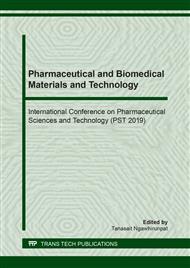p.202
p.209
p.215
p.221
p.227
p.233
p.240
p.246
p.252
Development and Evaluation of Acetaminophen Orodispersible Disc with Taste-Masking Property
Abstract:
Orodispersible tablet (ODT) provides rapid disintegration in the oral cavity. ODT improves the efficacy of using medicines especially in term of compliance in a patient with dysphagia. The major challenge of ODT is a bitter taste of active pharmaceutical ingredient (API); they can lead the patients to refuse medication. This study focused on the developing of the orodispersible disc (ODD) with a taste masking property by preparation of API particle that was taste-masked by polymers. The co-precipitation technique was used for the taste masking. Acetaminophen (APAP) taste-masked particles prepared with different grades of crospovidone were investigated for the taste-masking property. Kollidon® CL-SF exhibited the lowest drug release. An increasing amount of Kollidon® CL-SF caused increasing of APAP release. Particles consisted of APAP:crospovidone at ratio 3:1 showed the lowest drug release. It was probably due to the complexation which was shown by the FT-IR and DSC. Taste-masked particles were compressed as ODD by a hydraulic press machine. The disintegrating time of ODD was at the range of 12.62-17.35 s. The dissolution of ODD was focused on the taste-masking zone (drug release in 1 min). The ODD with ratio 3:1 particle (APAP: Kollidon® CL-SF) showed the highest taste-masking performance, the lowest drug release. All disc formulations completely released APAP after 30 min. Therefore, the preparation of ODD contains taste-masked particles was promising to improve patient compliance of bitter APIs.
Info:
Periodical:
Pages:
233-239
Citation:
Online since:
August 2019
Price:
Сopyright:
© 2019 Trans Tech Publications Ltd. All Rights Reserved
Share:
Citation:


